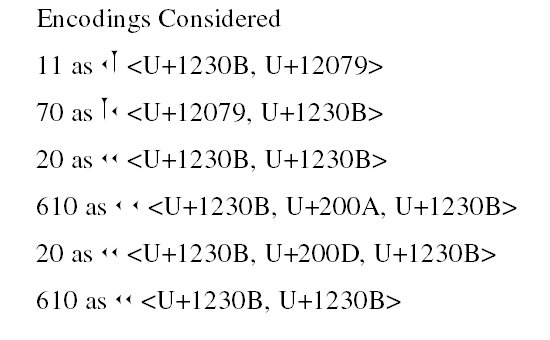- Previous message: Mark Davis: "FYI: Google posting about U5.1"
- Messages sorted by: [ date ] [ thread ] [ subject ] [ author ] [ attachment ]
- Mail actions: [ respond to this message ] [ mail a new topic ]
I am having problems writing up a discussion on Babylonian mathematics using
cuneiform numbers.
For the benefit of those without a cuneiform font, I have included the
numbers I mention in the attached file.
While one can satisfactorily write 11 as 𒌋𒁹 <U+1230B CUNEIFORM SIGN U,
U+12079 CUNEIFORM SIGN DISH> and 70 (= 60 + 10) as 𒁹𒌋 <U+12079 CUNEIFORM
SIGN DISH, U+1230B CUNEIFORM SIGN U>, I do not know the standard way to
write 20 and 610 in plain text using U and DISH. (My problem would be
solved immediately if there were a CUNEIFORM SIGN U U analogous to U+1230D
CUNEIFORM SIGN U U U, but I presume the consortium's position is that its
absence should not be regarded as a mistake.)
My current solution is:
Write 20 as 𒌋𒌋 <U+1230B, U+1230B>;
write 610 as 𒌋 𒌋 <U+1230B, U+200A HAIR SPACE, U+1230B>.
However, another plausible solution, except that the font I am using does
not form ligatures, is:
Write 20 as 𒌋𒌋 <U+1230B, U+200D ZWJ, U+1230B>;
write 610 as 𒌋𒌋 <U+1230B, U+1230B>.
I trust that at least one of these schemes is wrong - otherwise we cannot
use Unicode to interchange Babylonian numbers! However, if the first scheme
is correct, what is the best spacing character to use? Perhaps I should be
using U+00A0 NO-BREAK SPACE? Or should I be using some other scheme? For
example, perhaps '20' should be <U+1230B, U+2060 WORD JOINER, U+1230B> -
should all the components of a number be defensively joined by WJ?
Richard.

- Next message: Kenneth Whistler: "Re: Undefined code positions in 8-bit character sets"
- Previous message: Mark Davis: "FYI: Google posting about U5.1"
- Messages sorted by: [ date ] [ thread ] [ subject ] [ author ] [ attachment ]
- Mail actions: [ respond to this message ] [ mail a new topic ]
This archive was generated by hypermail 2.1.5 : Mon May 05 2008 - 14:32:06 CDT